Located at the southward extension of China-proposed Belt and Road Initiative (BRI), the Pacific Island Countries (PICs) are economic and trade partners of China.
To illustrate how the BRI vision has become a reality over the past decade, Global Times reporters visited a variety of countries and regions in Southeast Asia, Africa, Central Asia, the South Pacific as well as Central and Eastern Europe, where they witnessed first-hand the success of the BRI and how it has improved life in those countries and regions.
This is the fourth installment based on a voyage embarked by Global Times reporters to several island countries scattered across the South Pacific where they sought to uncover how the BRI has contributed to local development.
Guadalcanal often welcomes sudden downpours around noon. However, at times, the sun shines bright, and the sea is calm. A palm-sized crab flips from the rocks into the crystal-clear water, and birds chirp.
It seems as if these scattered Pacific islands, like stars in the sky, have remained this way forever, where people accept nature’s gifts, or its challenges.
When Westerners learned of these islands, they named this country after the story of King Solomon, hoping to find gold here. But gold was not found, and during World War II, the Solomon Islands, with Guadalcanal as its principal island, became known as one of the most brutal battlefields.
Eighty years later, the Solomon Islands have regained tranquility, but they remain one of the United Nations-listed world’s least developed countries.
Yet, tranquility does not mean standing still, as the islanders are eagerly anticipating real development.
In the past few years, China has carried out thousands of small-scale projects in fifty constituencies to improve the livelihood of local people; A dedicated medical team has consistently provided medical services and professional training to local healthcare personnel; Additionally, a brand-new sports center has been completed, allowing the Solomon Islands to be a proud host of the upcoming Pacific Games.
All these changes have been made possible under the framework of the Belt and Road Initiative. In 2019, less than a month after establishing diplomatic relations with China, the Solomon Islands formally joined the Belt and Road Initiative.
“Our country is collaborating closely with China as part of the Belt and Road Initiative, a transformative force in infrastructure development that plays a crucial role in our nation’s progress,” Solomon Islands Prime Minister Manasseh Sogavare told the Global Times.
“We are proud to be a participant in this remarkable initiative, which aligns with our infrastructure needs and development goals,” said the Prime Minister.
A century ago, the ancestors of the Chinese merchants diaspora set sail and drifted to the Solomon Islands, seeking for a living; A hundred years later, following the Maritime Silk Road, more Chinese enterprises and individuals have arrived on this Pacific Island country, hoping to bring further development through their interactions.
The Solomon Islands is a representative of Pacific Island nations participating in the Belt and Road Innitiative.
These countries, located in the Pacific region, are remote but blessed with beautiful natural scenery and abundant marine resources. However, due to their geographical isolation and relatively small economies, these nations face a range of development challenges, including inadequate infrastructure, economic diversification, and climate change. In this context, the Belt and Road Innitiative presents an opportunity for Pacific Island nations to achieve sustainable development.
In November 2014, President Xi Jinping stressed that the South Pacific region is also a natural extension of the 21st-Century Maritime Silk Road initiative put forward by China.
Currently, China’s relations with Pacific Island countries have entered a new stage of rapid development. Their friendly history of interactions, practical cooperation achievements, and shared vision illuminate a brighter future for China’s relations with Pacific Island nations.
While journeying through several Pacific nations, each at different stages of development and with unique status, Global Times reporters found that the Belt and Road Initiative has ingeniously aligned with local development needs.
Ride the wave
“Slowly and carefully,” Lin Xingsheng crouched on the muddy ground, demonstrating to several Fijian students how to harvest a ripe mushroom.
A local student, under Lin’s direction, gently holds the oyster mushroom in his hands, like holding a pristine peony. These precious mushrooms will find their way onto local dinner tables – deep fried as local people love.
It is in a greenhouse located at Votualevu College in Nadi, just a fifteen-minute drive from Nadi International Airport. When the Global Times reporter arrived, a dozen students were undergoing several weeks of agricultural technology training here. Mushroom cultivation is one of the skills they are learning.
Seeing visitors, the students don’t hesitate to share their smiles with curiosity. “I’d like to apply this skill at home,” said 17-year-old Taufa Tupou.
Like Tupou, the students and teachers at the college see the training as an opportunity to improve the welfare of their families and communities.
Lin, originally a professor at Fujian Agriculture and Forestry University, currently serves as the leader of the expert group promoting the technology of mushroom planting in Fiji. “Our center provides free technical training to local farmers and supplies them with mushroom bags. This is a very profitable project, but easy to operate.”
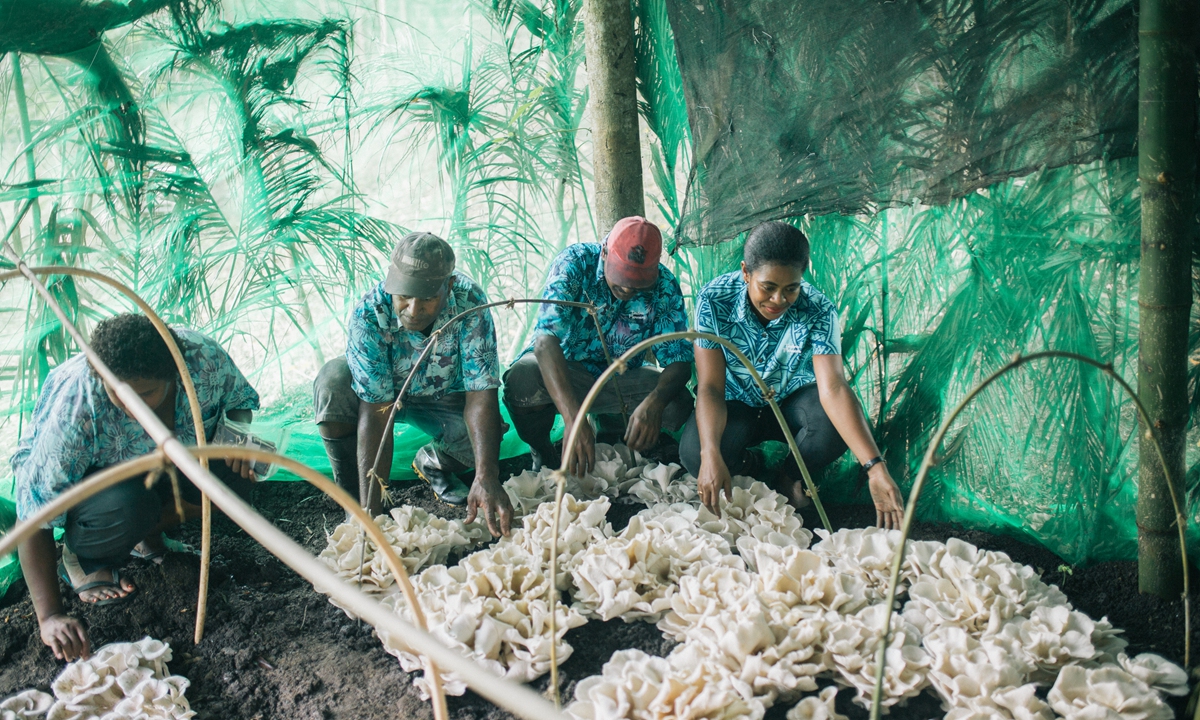
Workers harvest mushrooms using Juncao technology at Tadra Farm near Nadi, Fiji on August 17, 2023. Photo: Shan Jie/GT
This technology, known as “Juncao” technology, consists of the cultivation of grass that can be used as a substrate for mushroom production, feed for animals, windbreaks, and to minimize soil erosion. It is a patented Chinese project, simple to operate, profitable, and highly suitable for poverty alleviation. It has been promoted in several Pacific Island countries for years.
Juncao technology has not only played a significant role in China’s poverty alleviation efforts but has also extended its reach globally, offering a Chinese solution to development challenges faced by developing countries and contributing China’s wisdom to global poverty reduction.
In Fiji, where temperatures are typically high, it was believed that Fiji is not suitable for growing mushrooms. However, after the arrival of a Chinese expert team, they successfully overcame the technical challenges that were affecting mushroom quality.
Juncao technology has paved the way for sustainable development in Fiji and has showcased its adaptability to different climates and conditions, exemplifying how Chinese expertise can benefit global communities.
Local experts say that the mushroom planting technology is a successful practice in the mutually beneficial cooperation between China and Fiji under the Belt and Road Initiative.
Fanny Fiteli, the founder of Fiji’s Mama’s mushroom, has been leading local women in rural areas to plant mushrooms. She told the Global Times that China’s Juncao technology has aided local women in Fiji by providing them with wage income and elevating their social status.
The promotion of Juncao cultivation reflects China’s foreign aid philosophy of “teaching people to fish” rather than simply providing aid, as well as the principles of equality, adaptability and sustainability. Promoting Juncao technology in South Pacific countries aligns with local natural conditions and allows local people to acquire a new technology, providing these countries with a sustainable development key.
In the past decade, this global cooperation initiative initiated by China has produced a far-reaching impact, especially for many countries, including Pacific Island countries. It has provided valuable opportunities for them to ride China’s development wave and share more opportunities and benefits.
At full sail
Flying from Nadi, Fiji to Honiara, the capital of the Solomon Islands, the aircraft’s livery features a cartoon image of a yellow sea turtle.
Its name is Solo, and it is the mascot of the 2023 Pacific Games.
This November, the Solomon Islands will host the Pacific Games for the first time. What the islanders are eagerly looking forward to sharing with the world is their newly constructed sports center. Paul Dere has worked for the project with the China Civil Engineering Construction Corporation since the commencing of the project two years ago, and now he serves as a local manager. Inside the azure sports complex, he told reporters, “I feel immensely proud, and everyone around me is excited about this stadium.”
Through a ceremony on August 18, the stadium project was handed over to the Solomon Islands from China.
Solomon Islands Prime Minister Sogavare said at the ceremony that the 2023 Pacific Games Stadium Project is “a gift” from the government and people of China to the government and people of the Solomon Islands.
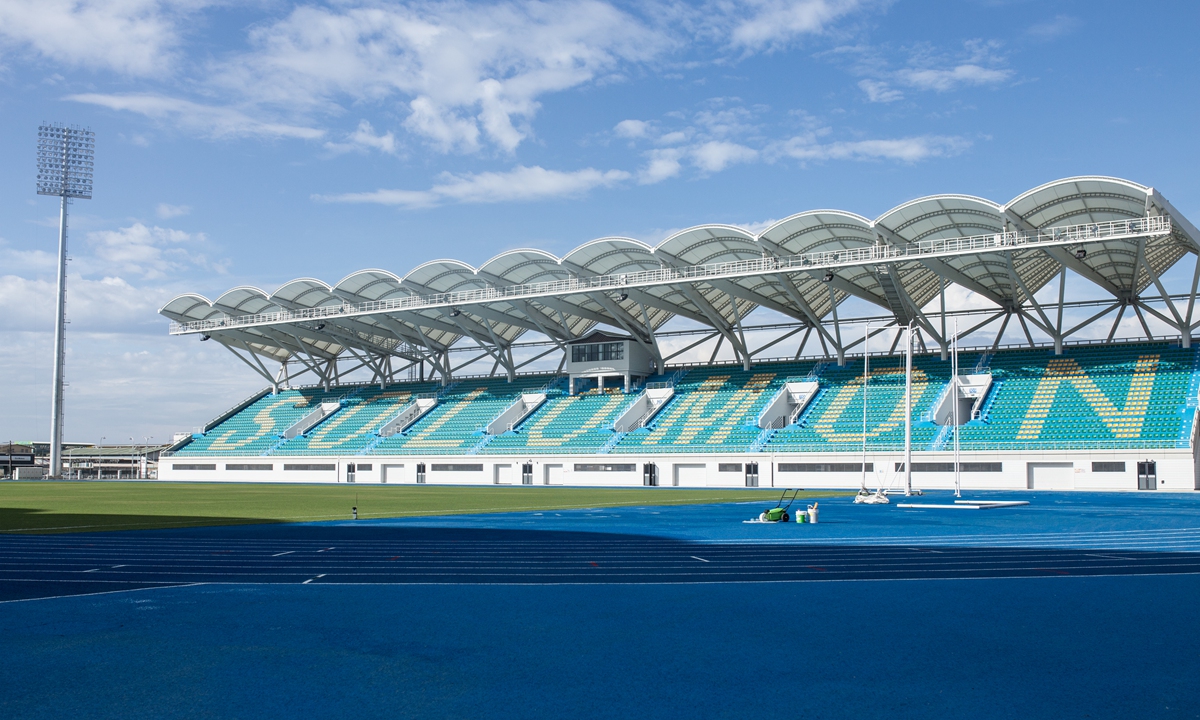
The 2023 Pacific Games Stadium Project in Honiara, Solomon Islands Photo: Shan Jie/GT
“Today this relationship is taken to new heights as we witness the handing over of the facilities to our country and to our people,” he said.
“This is a symbol of the China-Solomon Islands friendship and a source of pride for the people of the Solomon Islands,” said China’s first Ambassador to the Solomon Islands Li Ming. “It is a significant achievement of the joint construction of the Belt and Road Initiative between China and the Solomon Islands.”
The 2023 Pacific Games Stadium Project consists of seven separate project components, with the main venue being a 10,000-seat National Stadium complex with a full-size football and rugby field and running tracks that comply with international standards. The project also has a swimming pool, a six-court tennis center, a five-a-side hockey field and a multi-purpose hall.
The Pacific Games sports stadium is the largest-scale infrastructure project that China has assisted in building in the Pacific Island region up to now.
Over the course of more than two years of project implementation, the Chinese construction enterprises have hired and trained nearly a thousand Solomon Islands employees, imparting professional skills to them. They have also procured building materials and other supplies worth millions of Solomon Islands dollars, promoting the economic development of the Solomon Islands and establishing a strong market reputation, according to Ambassador Li.
The development of China’s relationship with the Solomon Islands has been a topic of great interest. Since establishing diplomatic relations in September 2019, the friendly ties between China and the Solomon Islands have rapidly grown, witnessed by the world. The Solomon Islands has greatly benefited from projects under the Belt and Road Initiative.
In addition to infrastructure development projects, China has become the Solomon Islands’ top trading partner and the primary destination for its exports. Exports to China account for two-thirds of the Solomon Islands’ total exports.
In 2022, the bilateral trade volume between the two countries reached $498 million. In the future, economic and trade cooperation between the two nations is expected to continue supporting the economic development of the Solomon Islands, as reported by the Xinhua News Agency.
On August 19th, the Chinese navy’s hospital ship Ark Peace docked at Honiara port for the first time. Over the following week, the ship provided medical services to tens of thousands of local people. It was also the first time that many islanders truly felt a connection with the Chinese people.
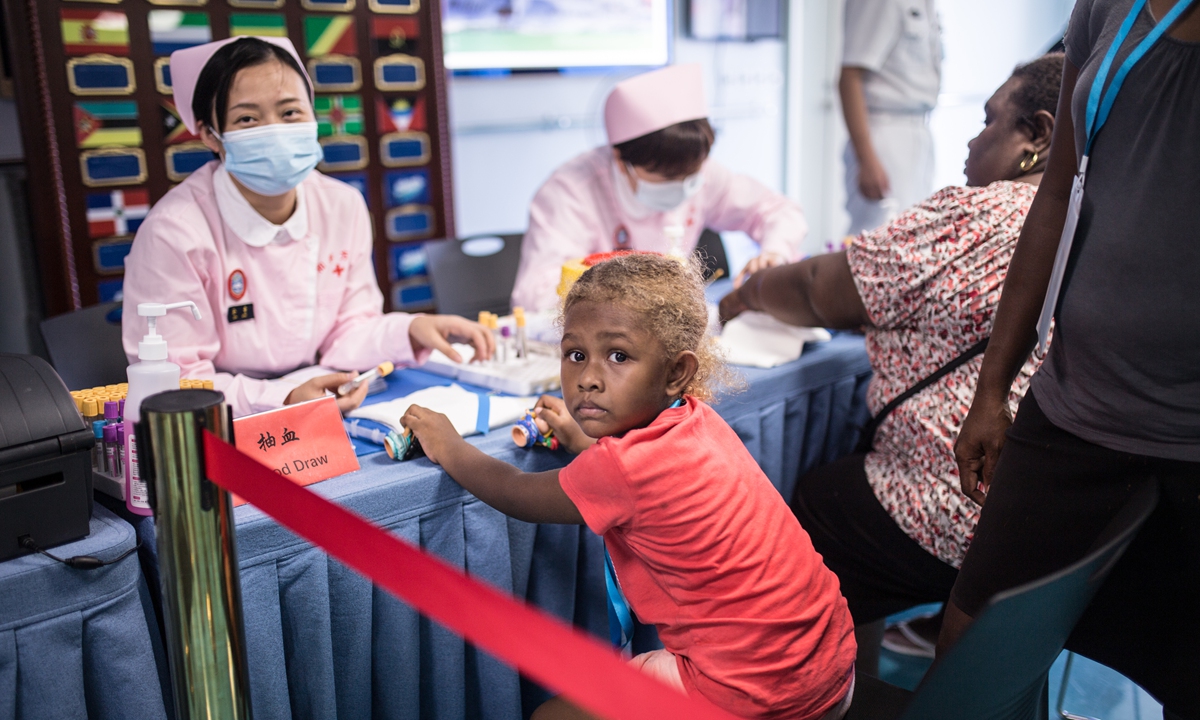
A child waits to be registered by a nurse on the Ark Peace on August 20, 2023 Photo: Shan Jie/GT
However, the good story was just the beginning. On August 2, the Solomon Islands National Broadband Network Infrastructure Project held a groundbreaking ceremony in a village of Guadalcanal Province.
Prior to this, the Solomon Islands government signed an agreement with a Chinese company to construct 161 communication towers across the country for the development of the national broadband network. This project will help 700,000 people scattered across hundreds of islands in the country achieve connectivity.
“China has a long-standing history of engagement with Pacific Island nations, dating back hundreds of years when Chinese immigrants crossed the seas and settled in the South Pacific, making positive contributions to local economic and social development. In the Pacific Island region, China is not a ‘newcomer’ but an ‘old friend,'” Ambassador Li told the Global Times.
“China welcomes Pacific Island nations to join the fast track of Chinese development and share in the fruits of development,” he stated.
Across the ocean
China’s long-standing friendly exchanges with Pacific Island nations have a deep-rooted history.
In ancient time, Chinese silk and porcelain made their way to the Pacific islands through Western trade ships, while products from the Pacific Island nations such as sandalwood, sealskin, and sea cucumber have consistently found their place in the Chinese market.
Since the 1970s, China’s cooperation and exchanges with these island nations have continued to expand, covering over 20 areas including trade and investment, marine environment, disaster reduction, poverty alleviation, healthcare, education, tourism, culture, sports, and numerous local initiatives.
China provides economic and technical assistance to island nations without attaching any political conditions; and it’s implementing over 100 aid projects, providing more than 200 batches of material assistance, and training nearly 10,000 personnel in various fields. China has dispatched medical teams to island nations 600 times, benefiting 260,000 people.
Over the past 20 years, bilateral trade has steadily expanded. According to Chinese statistics, from 1992 to 2021, the total trade volume between China and countries in the Pacific Island region that have established diplomatic ties with China grew from $153 million to $5.3 billion, averaging an annual growth rate of 13 percent, an increase of more than 30 times over 30 years.
Governments and businesses from countries in the region that have established diplomatic ties with China actively participate in the China International Import Expo. Bilateral investment has made steady progress, with China’s direct investment in island countries that have established diplomatic ties with China reaching $2.72 billion by the end of 2021.
Chinese enterprises, rooted in the local market, have promoted project localization and local procurement, contributing to local economic development and improved livelihoods, providing numerous job opportunities for locals.
Moreover, the Belt and Road Initiative has also gained recognition from developed countries like New Zealand.
For instance, Global Times reporters visited the Chinese food firm Yashili’s dairy factory in Pokeno, just an hour’s drive from Auckland, New Zealand, learning that since its construction and operation in 2013, Yashili has made significant contributions to the economic and community development of the Whakatane region, driving investments into the area.
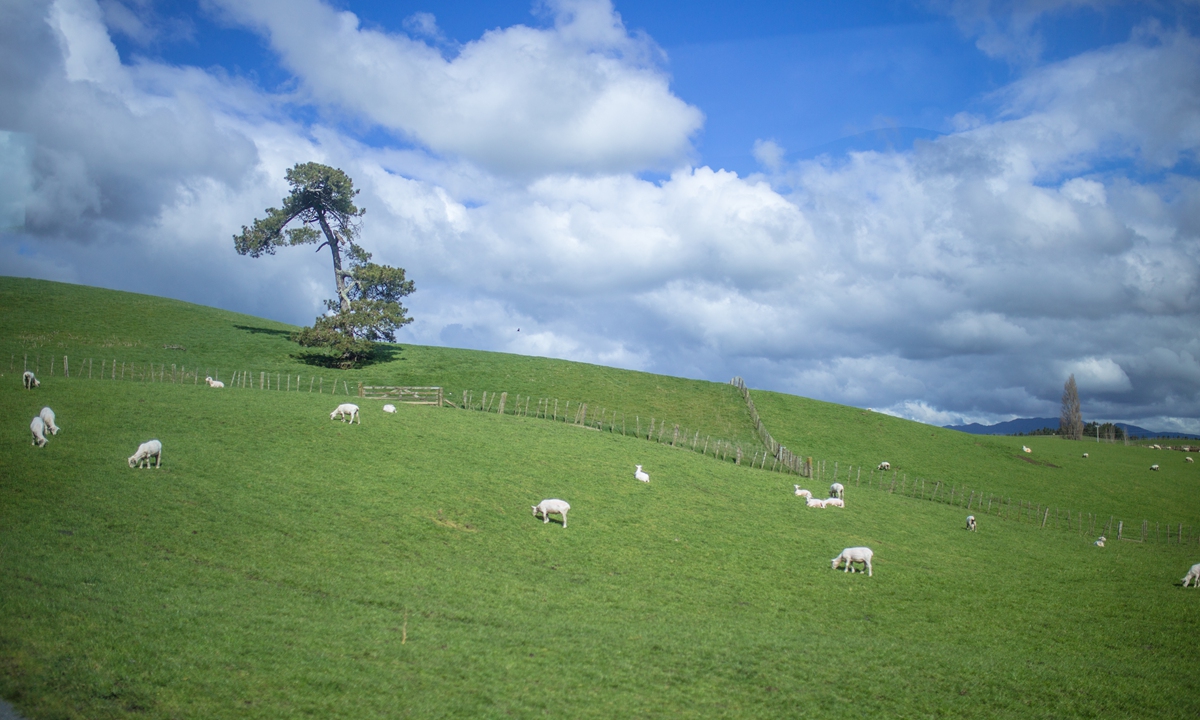
The scenery of New Zealand Photo: Shan Jie/GT
Furthermore, high-quality dairy products produced in New Zealand are exported to China, Southeast Asia, Europe, and other regions.
New Zealand is the first developed Western economy to sign a Memorandum of Understanding on the Belt and Road with China.
Stephen Jacobi, then executive director of the New Zealand China Council, told media in 2019 that each country has to decide for itself how it wants to be involved, and there should be “a uniquely Kiwi way” of being involved in the Belt and Road Initiative.
Apart from economic development, China places a strong emphasis on sustainable development when cooperating with South Pacific countries as part of the Belt and Road Initiative.
China is acutely aware of the unique challenges and concerns of the Pacific Island nations regarding climate change and is committed to helping them to strengthen their capacity to address climate change.
In April 2022, the China-Pacific Island Countries Climate Change Cooperation Center was officially inaugurated in East China’s Shandong Province in order to implement the Belt and Road Initiative and the concept of “a community with a shared future for mankind.”
Since 2019, China has hosted several training programs on climate change and green low-carbon development specifically for Pacific Island countries. It has also provided multiple shipments of climate change-related aid to these countries.
China places a significant focus on enhancing cooperation with Pacific Island countries in the field of renewable energy. China supports Chinese enterprises’ participation in projects related to hydropower stations in countries like Papua New Guinea and Fiji.
“For Pacific Island nations, climate change matters affect their survival,” Chen Dezheng, director at the China-Pacific Island Countries Climate Change Cooperation Center, told the Global Times. “Meanwhile, China not only possesses strong climate governance capabilities, but also has achieved remarkable results in recent years. China can provide assistance within its capacity to island countries in addressing climate change.”
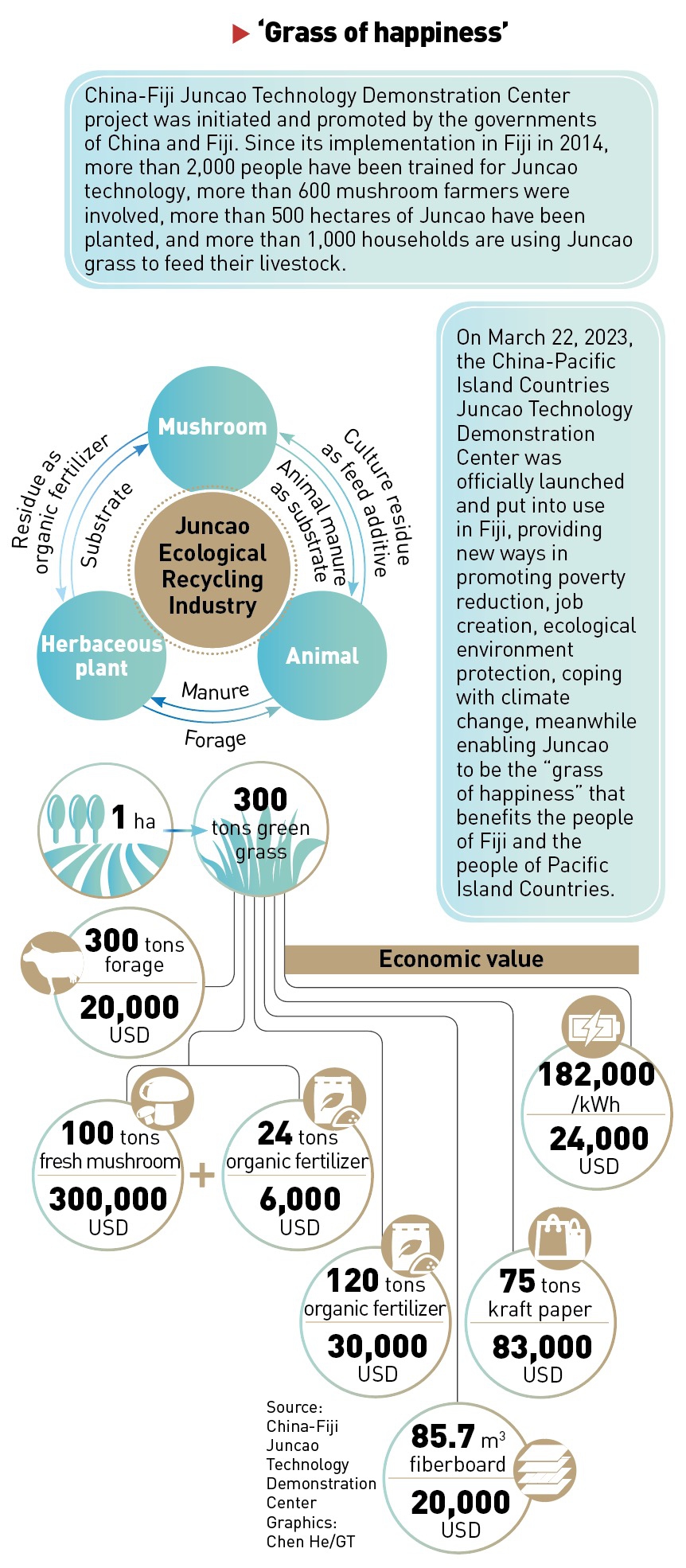
Graphics: Chen He/GT
(Global Times)




